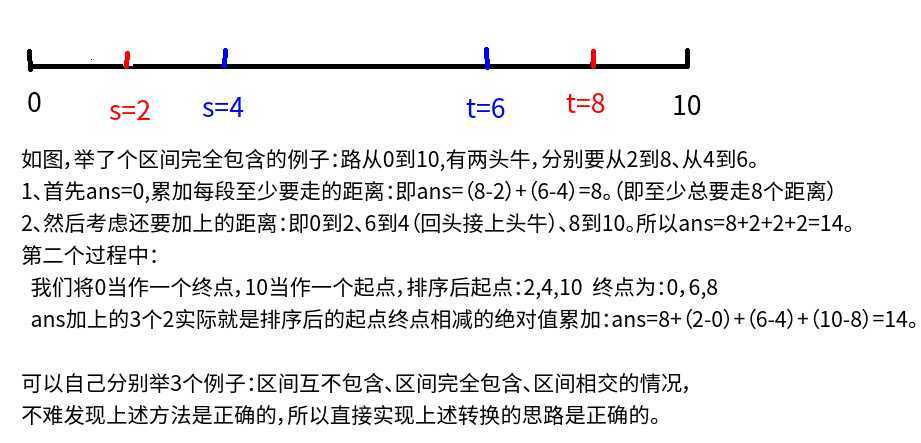标签:+= ssi nis jpg ref length \n image ==
Bessie is running a taxi service for the other cows on the farm. The cows have been gathering at different locations along a fence of length M (1 <= M <= 1,000,000,000). Unfortunately, they have grown bored with their current locations and each wish to go somewhere else along the fence. Bessie must pick up each of her friends at their starting positions and drive them to their destinations. Bessie‘s car is small so she can only transport one cow in her car at a time. Cows can enter and exit the car instantaneously.
To save gas, Bessie would like to minimize the amount she has to drive. Given the starting and ending positions of each of the N cows (1 <= N <= 100,000), determine the least amount of driving Bessie has to do. Bessie realizes that to save the most gas she may need to occasionally drop a cow off at a position other than her destination.
Bessie starts at the leftmost point of the fence, position 0, and must finish her journey at the rightmost point on the fence, position M.
长度为m的栅栏上,有n头牛需要坐车前往别的地方,起点和终点分别为a_i和b_i。现在出租车从最左端0出发,要运送完所有牛,最后到达最右端m,求最小路程。
输入格式:
Line 1: N and M separated by a space.
Lines 2..1+N: The (i+1)th line contains two space separated
integers, s_i and t_i (0 <= s_i, t_i <= M), indicating the starting position and destination position of the ith cow.
输出格式:
输入样例#1:
2 10
0 9
6 5
输出样例#1:
12
There are two cows waiting to be transported along a fence of length 10. The first cow wants to go from position 0 (where Bessie starts) to position 9. The second cow wishes to go from position 6 to position 5.
Bessie picks up the first cow at position 0 and drives to position 6. There she drops off the first cow, delivers the second cow to her destination and returns to pick up the first cow. She drops off the first cow and then drives the remainder of the way to the right side of the fence.
首先当然是要安利一波five20巨佬的博客
一句话题意: 有\(n\)头奶牛的行程,以及它们的起点和终点.每个时刻只能带一个奶牛,现在要求从0出发,送每个奶牛从起点出发到终点,最终到\(m\)位置所需要的最少的路程.
题解: 首先可以想到,要送到一只奶牛,至少要从它的起点走到终点.那么该如何求出除了必须走的路程以外还要额外走的路程呢?
如果我们不考虑每头牛走到它自己的终点,只要它走到最近的终点,那么应该怎么做呢?显然可以直接将0加入起点,\(m\)加入终点,将起点和终点排序,这样算出的就是最小要走的距离.
那么如果每头牛都有它自己固定的起点终点呢?其实也是一样的,因为每个时刻我们车上都可以带一头牛,所以可以现将每头牛都先送到最近的终点,那么现在的情况虽然并不是题目要求的答案,但是每次我送一头牛到它应该到的位置的时候可以把现在在这个终点的那头牛接上车.然后再送这头牛回到它要去的终点.
该怎么理解上面这段话呢?打个栗子,这里引用一下520的图:

假设牛\(i\)的起点为s=2,终点为t=8,牛\(j\)的起点为s=4,终点为t=6,那么我们模拟一下送这两头牛的过程:
当然因为是从0出发,最后要到\(m\),所以要先将0加入终点,\(m\)加入起点,然后排序算出的结果可以发现是一样的,实际上也可以证明这个是正确的.
最后记得结果开long long.
#include<bits/stdc++.h>
using namespace std;
const int N=100000+5;
typedef long long lol;
int n, m, a[N], b[N];
lol ans = 0;
int gi(){
int ans = 0, f = 1; char i = getchar();
while(i<'0'||i>'9'){if(i=='-')f=-1;i=getchar();}
while(i>='0'&&i<='9'){ans=ans*10+i-'0';i=getchar();}
return ans * f;
}
int main(){
//freopen("data.in","r",stdin);
n = gi(); m = gi();
for(int i=1;i<=n;i++)
a[i] = gi(), b[i] = gi(), ans += abs(b[i]-a[i]);
a[0] = m, b[0] = 0;
sort(a, a+n+1); sort(b, b+n+1);
for(int i=0;i<=n;i++) ans += abs(a[i]-b[i]);
printf("%lld\n",ans);
return 0;
}标签:+= ssi nis jpg ref length \n image ==
原文地址:https://www.cnblogs.com/BCOI/p/9058261.html